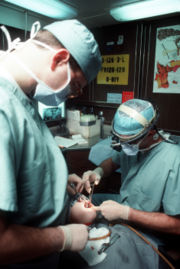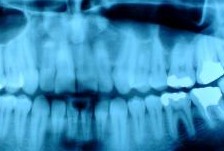|
|
 |
| Dentistry |
 |
 |
 |
|
|
Dentistry is the art and science
of prevention, diagnosis, and treatment of conditions, diseases, and
disorders of the oral cavity, the maxillofacial region,
and its associated structures as it relates to human
beings. Dental hygienists work with people of all ages and
have responsibility for both prevention and treatment of
dental disease. Dental hygiene prevents oral disease such
as cavities, gum disease and for educating patients in
prevention of dental problems.
diagnosis, and treatment of conditions, diseases, and
disorders of the oral cavity, the maxillofacial region,
and its associated structures as it relates to human
beings. Dental hygienists work with people of all ages and
have responsibility for both prevention and treatment of
dental disease. Dental hygiene prevents oral disease such
as cavities, gum disease and for educating patients in
prevention of dental problems. |
|
|
|
Everyone would like to have a perfect smile, but nature is
rarely so accommodating. Even if you're one of the lucky
ones who never needed braces, the rough-and-tumble of
life, along with habits such as smoking or drinking
coffee, invariably result in chips, stains, or an overall
dingy appearance. Until fairly recently, there wasn't a
lot you could do to improve the appearance of your teeth
beyond having them cleaned once or twice a year. In the
last decade, however, improvements in dental materials and
restorative techniques have made it possible for most of
us to have close to model-perfect teeth that resist colour
changes and are almost as strong as the originals. It's
important to be realistic. Dentists who specialize in
cosmetic procedures are enhancers. They can manipulate,
shape and polish materials in an infinite variety of ways
to create smiles that are truly dazzling. What they can't
do is change the shape of your mouth, the color of your
skin or your overall appearance. In order for tooth
restorations to truly look natural, they have to be work
for you. Cosmetic dentistry can improve your appearance;
it won't completely transform it. |
|
|
There are nine dental specialties recognized by the
American Dental Association and require 2-6 years of residency
training after dental school. The specialties are Dental
Public Health (study of dental epidemiology and social
health policies), Endodontics (root canal therapy), Oral
and Maxillofacial Pathology (study, diagnosis, and often
the treatment of oral and maxillofacial related diseases),
Oral and Maxillofacial Radiology (study and radiologic
interpretation of oral and maxillofacial diseases), Oral
and Maxillofacial Surgery (extractions and facial
surgery), Orthodontics and Dentofacial Orthopaedics
(straightening of teeth), Pedodontics (pediatric
dentistry; i.e. dentistry for children), Periodontics
(treatment of gum disease), Prosthodontics (replacement of
missing facial anatomy by prostheses such as dentures,
bridges and implants).
Dental Association and require 2-6 years of residency
training after dental school. The specialties are Dental
Public Health (study of dental epidemiology and social
health policies), Endodontics (root canal therapy), Oral
and Maxillofacial Pathology (study, diagnosis, and often
the treatment of oral and maxillofacial related diseases),
Oral and Maxillofacial Radiology (study and radiologic
interpretation of oral and maxillofacial diseases), Oral
and Maxillofacial Surgery (extractions and facial
surgery), Orthodontics and Dentofacial Orthopaedics
(straightening of teeth), Pedodontics (pediatric
dentistry; i.e. dentistry for children), Periodontics
(treatment of gum disease), Prosthodontics (replacement of
missing facial anatomy by prostheses such as dentures,
bridges and implants). |
|
Specialists in these
fields are designated registrable (U.S. "Board
Eligible") and warrant exclusive titles such as
orthodontist, oral surgeon, pedodontist,
periodontist, or prosthodontist upon satisfying
certain local (U.S. "Board Certified") registry
requirements.
Two other post-graduate formal advanced education programs: General Practice Residency (advanced
clinical and didactic training with intense hospital
experience) and Advanced Education in General
Dentistry (advanced training in clinical dentistry)
recognized by the ADA do not lead to specialization.
programs: General Practice Residency (advanced
clinical and didactic training with intense hospital
experience) and Advanced Education in General
Dentistry (advanced training in clinical dentistry)
recognized by the ADA do not lead to specialization.
Other dental education exists where no post-graduate
formal university training is required: cosmetic
dentistry, dental implant, temporo-mandibular joint
therapy. These usually require the attendance of one
or more continuing education courses that typically
last for one to several days. There are restrictions
on allowing these dentists to call themselves
specialists in these fields. The specialist titles
are registrable titles and controlled by the local
dental licensing bodies.
Forensic odontology consists of the gathering and
use of dental evidence in law. This may be performed
by any dentist with experience or training in this
field. The function of the forensic dentist is
primarily documentation and verification of
identity.
Geriatric dentistry or geriodontics is the delivery
of dental care to older adults involving the
diagnosis, prevention, and treatment of problems
associated with normal aging and age-related
diseases as part of an interdisciplinary team with
other health care professionals.
Veterinary dentistry, a specialty of veterinary
medicine, is the field of dentistry applied to the
care of animals |
|
|
Dentistry in India
Modern Indian dentists must earn the Bachelor of
Dental Surgery degree (B.D.S.), which requires four years
of study and one year of internship. This degree is
overseen by the Dental Council of India. In most
states, one has to appear for an entrance test
conducted by the Directorate of Medical Education,
whereas some autonomous universities conduct their
own entrance tests.Post graduate courses (Master of
Dental Surgery. MDS) are also available in different
specialities.It requires 3 years of study after
BDS.Find informations on Dental Health The
Specialisation(MDS) is available in the following
specialities - Orthodontics,Oral and Maxillofacial
Surgery, Conservative and endodontics, Periodontics,
Prosthodontics, Pediatric Dentistry, Oral Pathology,
Oral medicine and Radiology, Community Dentistry.
Although many institutions are offering other short
or long courses in Dental Implantology and esthetic
Dentistry, These are yet to be regularised by the
Council. Almost all Dental Colleges have a fixed
number of seats for foreign students including non
resident indians.
Surgery degree (B.D.S.), which requires four years
of study and one year of internship. This degree is
overseen by the Dental Council of India. In most
states, one has to appear for an entrance test
conducted by the Directorate of Medical Education,
whereas some autonomous universities conduct their
own entrance tests.Post graduate courses (Master of
Dental Surgery. MDS) are also available in different
specialities.It requires 3 years of study after
BDS.Find informations on Dental Health The
Specialisation(MDS) is available in the following
specialities - Orthodontics,Oral and Maxillofacial
Surgery, Conservative and endodontics, Periodontics,
Prosthodontics, Pediatric Dentistry, Oral Pathology,
Oral medicine and Radiology, Community Dentistry.
Although many institutions are offering other short
or long courses in Dental Implantology and esthetic
Dentistry, These are yet to be regularised by the
Council. Almost all Dental Colleges have a fixed
number of seats for foreign students including non
resident indians. |
|
| Organizations |
|
India
o- Indian Dental Association
[24]
o- Indian Othodontic Society
[25]
|
|
There are many cosmetic
options to choose from, depending on what you need
to have done. For example:
Stained or discolored
teeth:: The enamel that covers the teeth
isn't impervious to stains and the underlying tooth
structure (the dentin) often yellows over time. As
long as the teeth are healthy, it's easy to
eliminate stains by applying a bleaching agent.
Chips or rough spots::
These can be filled with a tooth-coloured material
called composite. The colour of the composite can be
chosen so that it matches the color of your teeth.
Once the material has been smoothed and polished,
it's virtually indistinguishable from the
surrounding area.
Cavities or cracks::
Traditional amalgam fillings work fine in the
back of the mouth, but most people don't want to
reveal a metal mouth when they smile. An alternative
is to use tooth-colored fillings, which match the
colour of the teeth. These fillings are made with
composite material similar to that used to repair
chips or cracks. Some white fillings (direct
composites) are pressed into the cavity and cured
(hardened) with a special ultraviolet light. Others
(indirect composites) are made in a laboratory and
then cemented in place. They cost much more than
amalgam fillings, but are much more attractive.
Uneven teeth::
It';s not uncommon for a tooth to be slightly longer
or have a different shape than its neighbours. With
a procedure called recontouring, your dentist can
reshape the tooth so that it's a better match.
Gaps between the teeth::
Small gaps can be closed by applying composite
material between the teeth. For large gaps or other
imperfections on the surfaces of the teeth, your
dentist may recommend veneers. Veneers are among the
most expensive cosmetic procedures. Made from
ultra-thin shells of porcelain that come in every
shade of white, veneers are permanently bonded to
the fronts of the teeth, giving them an entirely new
esthetic appearance.
Broken or crooked teeth::
If a tooth has been badly broken or is
structurally weak, you may need a crown. Crowns used
to be made of metal, but today they're often made of
tooth-coloured porcelain materials.
The foll conservative cosmetic dental procedures
have greatly enhanced a dentist's ability to give
their patientsa better smile. |
|
Specific professional
activities of the dental hygienist include initial
screening examination and charting of each patient's
teeth, soft tissue and other oral structures;
removal of calculus and plaque from above and below
the gumline; application of caries-preventive agents
such as fluoride and dental sealants; plaque control
instruction and development of individualized oral
hygiene programs for home care.
Other professional activities might include
gathering data for the dental diagnosis, such as:
patient medical history; dietary analysis, dental
X-ray exposure, processing and interpretation;
placement of temporary fillings and periodontal
dressings; removal of sutures; and office
management. |
|
|
|
Disclaimer - The
contents of this site are for informational purposes
only. Always seek the advice of a qualified
physician for any doubts. |
| | |


